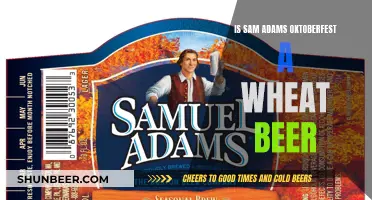
Wheat beer is a top-fermented beer brewed with a large proportion of wheat relative to the amount of malted barley. The two main varieties are German Weizenbier and Belgian witbier, with other types including Lambic (made with wild yeast), Berliner Weisse (a cloudy, sour beer), and Gose (a sour, salty beer). Wheat beers are usually top-fermented and can vary in flavour depending on the style. Wheat beers can be brewed with or without gluten, and some breweries use an enzymatic process to reduce the gluten content.
What You'll Learn

German Weizenbier
The name "hefeweizen" comes from the German words "hefe", meaning yeast, and "weizen", meaning wheat. The yeast remains in suspension, giving the beer its cloudy appearance. The aroma and flavour of a Weizenbier come largely from the yeast and are characterised by fruity (banana) and phenolic (clove) notes. The intensity of these flavour qualities can vary depending on the brewer, but they are typically well-balanced.
Weizenbier has a low to moderate alcohol content and is considered the most popular among the German Weizenbier varieties. It is best served in a large, curvaceous glass called a "weizen vase", which showcases the beer's beautiful glow and generous foam head. The bright fruitiness of banana and the pungency of clove make Weizenbier a versatile food pairing option, complementing a variety of lighter dishes such as salads, seafood, and egg dishes.
The four largest brands of Weizenbier in Germany are Erdinger, Paulaner, Franziskaner, and Maisel. Other renowned brands include Augustiner, Weihenstephaner, Schneider (known for its bronze-coloured specialty), and Andechser. Regional brands in Bavaria include Hopf, Unertl, Ayinger, Schweiger, and Plank.
Weizenbier has a long history in Germany, dating back to the 15th century when it was introduced to Bavaria from neighbouring Bohemia. However, it was not until 1548 that William IV, Duke of Bavaria, granted special permission to Baron Hans VI von Degenberg to brew and sell wheat beer. Today, Weizenbier is well-known throughout Germany, although it is better known as "Weizen" outside of its region of origin, Bavaria.
Wheat Beer's Halal Status: What Muslims Should Know
You may want to see also

Belgian witbier
Belgian-style witbier is a wheat beer that is brewed using unmalted wheat, sometimes oats, and malted barley. It is spiced with coriander and orange peel, and is pale and cloudy in appearance due to the high level of wheat used in the mash. Witbiers are often referred to as "white beer" as the word "wit" in Flemish means "white", referring to the beer's bright colour and thick, foamy head. The style dates back hundreds of years but fell into relative obscurity until it was revived by Belgian brewer Pierre Celis in the 1960s.
The wheat and oats in witbiers deliver a distinct bready quality to the beer, resulting in a smooth, creamy flavour that is light on the palate. This style of beer is best paired with lighter foods such as salads, cheese (especially goat and sheep's milk varieties), fish, seafood, and sushi.
Yeungling Beer: Wheat or Not?
You may want to see also

Lambic
After boiling, the wort is exposed to airborne yeast and bacteria overnight, then pumped into wooden casks, where it undergoes fermentation by various wild yeasts and bacteria, including Brettanomyces lambicus, Brettanomyces bruxellinsis, and Lactobacillus. This produces a beer that is not only sour but also exhibits a range of other characteristics, including a horse blanket or barnyard character.
Carlsberg Beer: Wheat-Free or Not?
You may want to see also

Berliner Weisse
The style's exact roots are a little unclear, but it is believed to have developed in the region around Berlin in the 17th century. Some believe that French immigrants who settled in Berlin implemented brewing techniques they had learned in Belgium, while others suggest that the style may have originated from the local red and brown ales of the time.
In Europe, it is traditional to add a schuss, or syrup, directly to the beer to play off its funky sourness. The syrup is usually either sweet raspberry syrup (red) or a more traditional grassy herb known as woodruff (green). In the United States, brewers often add their own twists to the traditional style by incorporating different combinations of fruit.
Shiner Bock: Wheat Beer or Not?
You may want to see also

Gose
By the 1960s, Gose had disappeared, with the last brewery producing it closing in 1966. However, the style was revived in the 1980s and has since regained popularity, especially in and around Leipzig, where there are now several specialised Gose breweries. Gose is also brewed outside of Germany, particularly in the United States and New Zealand.
Juicer Beer: Is It a Wheat Beer?
You may want to see also
Frequently asked questions
Wheat beers are top-fermented beers brewed with a large proportion of wheat relative to the amount of malted barley.
The two main varieties are German Weizenbier and Belgian witbier.
Other types of wheat beer include Lambic (made with wild yeast), Berliner Weisse (a cloudy, sour beer), and Gose (a sour, salty beer).







